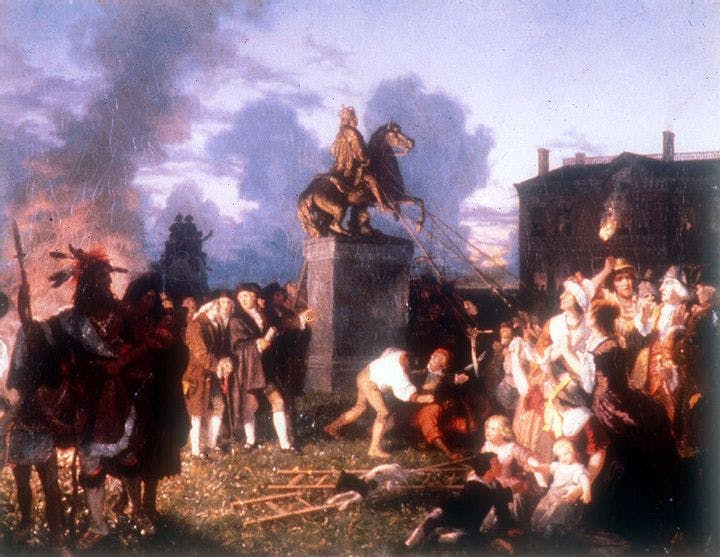Fall 2007
A Royalist Revolution
– The Wilson Quarterly
American colonists were "married to royal political spectacles" and "championed their British king with emotional intensity" right up to the eve of the Revolution, says one historian.
“Most historians still treat the years between 1688 and 1776 as somehow a long prologue to the revolutionary crisis,” writes Brendan McConville, a historian at Boston University. In their examination of pre-Revolutionary War society, they look for and find the roots of capitalism and the democratic society that was to come—“in short, future Americans.” They all but ignore evidence, from printed pamphlets to the knickknacks decorating colonial homes, showing that “an ever-growing number of provincials identified themselves as Britons” after 1688 and “proclaimed their love of Britain’s Protestant monarchs and loathing for the kings’ enemies, particularly papists of all stripes.”
This royalist bent, McConville says, “has been gradually wiped from our national memory,” partly because a land filled with “proto-republicans” makes the eventual revolution easier to explain. But in his view, it was the colonists’ allegiance to the Crown that led to the explosions at Lexington and Concord in 1775.
In England, the Glorious Revolution in 1688 permanently established the primacy of the Parliament over the crown, but the Crown’s dynastic struggles were far from over. The later Stuart kings became enmeshed in a series of wars and intrigues on the Continent, eventually leading to the ascension of the German-born Hanoverian kings in 1714. The English felt “tepid at best” toward these new foreign-born royals, but their allegiance to their government was bolstered by the elaborate system of political patronage in England, the religious and social authority of the Protestant Church of England, and the “fixed and controlled land-tenure system.”
The distant Americans saw these events very differently. Parliament did not loom large in the colonists’ understanding; nor did any of these ties of allegiance hold sway. Far more important to them was the resolution of the long-simmering conflict between Protestants and Catholics that had existed since Henry VIII severed ties with Rome and established the Church of England in 1534. “They saw the national settlement,” McConville says, “as establishing the Protestant succession and a Protestant political culture built around a cult of benevolent monarchy.”
Colonial society was “married to royal political spectacles and a slavishly loyal print culture,” McConville writes, and “British North Americans championed their British king with emotional intensity.” For example, on Pope’s Day, observed in November, Bostonians annually reenacted the suppression of a Catholic uprising against the king in 1605. “The result was a polity sown together by passions rather than patronage,” McConville observes.
In the decades immediately preceding the Revolution, as the colonial population exploded and settlers began pushing out into the frontier, everyone from yeoman farmers to Native Americans resisting the encroaching settlers invoked Britain’s kings in support of their cause. But beginning in the 1760s, Parliament attempted to exert its authority over the colonies and subsequently levied a series of unpopular taxes. The spell was broken, and the underlying incoherence of the colonists’ bonds with the mother country was revealed. By the time the statue of King George III in New York’s Bowling Green was pulled down on July 9, 1776, any remaining bonds with the king had been permanently severed, and, as McConville writes, “the long struggle to make a workable republican society began.”
* * *
The Source: "A World of Kings" by Brendan McConville, in Historically Speaking, May-June 2007.
Image courtesy of Wikimedia Commons
